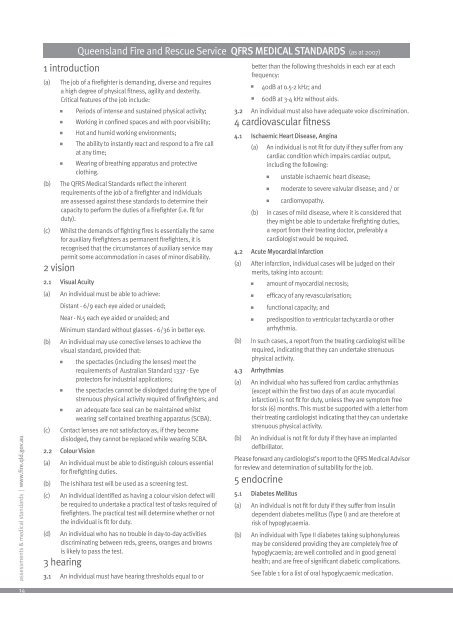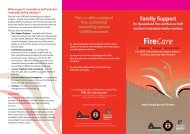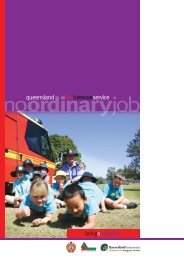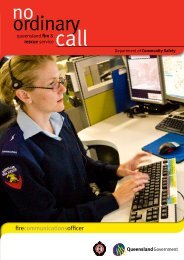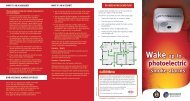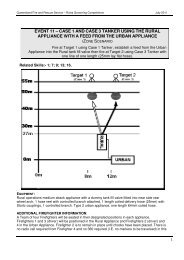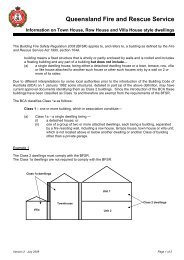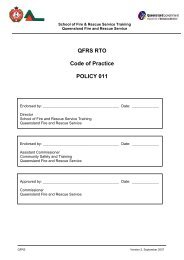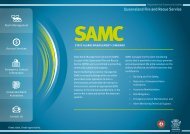QFRS Medical Standards, click here - Queensland Fire and Rescue ...
QFRS Medical Standards, click here - Queensland Fire and Rescue ...
QFRS Medical Standards, click here - Queensland Fire and Rescue ...
You also want an ePaper? Increase the reach of your titles
YUMPU automatically turns print PDFs into web optimized ePapers that Google loves.
assessments & medical st<strong>and</strong>ards | www.fire.qld.gov.au<br />
1 introduction<br />
(a)<br />
(b)<br />
(c)<br />
The job of a firefighter is dem<strong>and</strong>ing, diverse <strong>and</strong> requires<br />
a high degree of physical fitness, agility <strong>and</strong> dexterity.<br />
Critical features of the job include:<br />
Periods of intense <strong>and</strong> sustained physical activity;<br />
Working in confined spaces <strong>and</strong> with poor visibility;<br />
Hot <strong>and</strong> humid working environments;<br />
The ability to instantly react <strong>and</strong> respond to a fire call<br />
at any time;<br />
Wearing of breathing apparatus <strong>and</strong> protective<br />
clothing.<br />
The <strong>QFRS</strong> <strong>Medical</strong> <strong>St<strong>and</strong>ards</strong> reflect the in<strong>here</strong>nt<br />
requirements of the job of a firefighter <strong>and</strong> individuals<br />
are assessed against these st<strong>and</strong>ards to determine their<br />
capacity to perform the duties of a firefighter (i.e. fit for<br />
duty).<br />
Whilst the dem<strong>and</strong>s of fighting fires is essentially the same<br />
for auxiliary firefighters as permanent firefighters, it is<br />
recognised that the circumstances of auxiliary service may<br />
permit some accommodation in cases of minor disability.<br />
2 vision<br />
2.1 Visual Acuity<br />
(a)<br />
(b)<br />
(c)<br />
An individual must be able to achieve:<br />
Distant - 6/9 each eye aided or unaided;<br />
Near - N.5 each eye aided or unaided; <strong>and</strong><br />
Minimum st<strong>and</strong>ard without glasses - 6/36 in better eye.<br />
An individual may use corrective lenses to achieve the<br />
visual st<strong>and</strong>ard, provided that:<br />
the spectacles (including the lenses) meet the<br />
requirements of Australian St<strong>and</strong>ard 1337 - Eye<br />
protectors for industrial applications;<br />
the spectacles cannot be dislodged during the type of<br />
strenuous physical activity required of firefighters; <strong>and</strong><br />
an adequate face seal can be maintained whilst<br />
wearing self contained breathing apparatus (SCBA).<br />
Contact lenses are not satisfactory as, if they become<br />
dislodged, they cannot be replaced while wearing SCBA.<br />
2.2 Colour Vision<br />
(a)<br />
(b)<br />
(c)<br />
(d)<br />
An individual must be able to distinguish colours essential<br />
for firefighting duties.<br />
The Ishihara test will be used as a screening test.<br />
An individual identified as having a colour vision defect will<br />
be required to undertake a practical test of tasks required of<br />
firefighters. The practical test will determine whether or not<br />
the individual is fit for duty.<br />
An individual who has no trouble in day-to-day activities<br />
discriminating between reds, greens, oranges <strong>and</strong> browns<br />
is likely to pass the test.<br />
3 hearing<br />
<strong>Queensl<strong>and</strong></strong> <strong>Fire</strong> <strong>and</strong> <strong>Rescue</strong> Service <strong>QFRS</strong> MEDICAL STANDARDS (as at 2007)<br />
3.1 An individual must have hearing thresholds equal to or<br />
better than the following thresholds in each ear at each<br />
frequency:<br />
40dB at 0.5-2 kHz; <strong>and</strong><br />
60dB at 3-4 kHz without aids.<br />
3.2 An individual must also have adequate voice discrimination.<br />
4 cardiovascular fitness<br />
4.1 Ischaemic Heart Disease, Angina<br />
(a)<br />
(b)<br />
An individual is not fit for duty if they suffer from any<br />
cardiac condition which impairs cardiac output,<br />
including the following:<br />
unstable ischaemic heart disease;<br />
moderate to severe valvular disease; <strong>and</strong> / or<br />
cardiomyopathy.<br />
in cases of mild disease, w<strong>here</strong> it is considered that<br />
they might be able to undertake firefighting duties,<br />
a report from their treating doctor, preferably a<br />
cardiologist would be required.<br />
4.2 Acute Myocardial Infarction<br />
(a)<br />
(b)<br />
After infarction, individual cases will be judged on their<br />
merits, taking into account:<br />
amount of myocardial necrosis;<br />
efficacy of any revascularisation;<br />
functional capacity; <strong>and</strong><br />
predisposition to ventricular tachycardia or other<br />
arrhythmia.<br />
In such cases, a report from the treating cardiologist will be<br />
required, indicating that they can undertake strenuous<br />
physical activity.<br />
4.3 Arrhythmias<br />
(a)<br />
(b)<br />
An individual who has suffered from cardiac arrhythmias<br />
(except within the first two days of an acute myocardial<br />
infarction) is not fit for duty, unless they are symptom free<br />
for six (6) months. This must be supported with a letter from<br />
their treating cardiologist indicating that they can undertake<br />
strenuous physical activity.<br />
An individual is not fit for duty if they have an implanted<br />
defibrillator.<br />
Please forward any cardiologist’s report to the <strong>QFRS</strong> <strong>Medical</strong> Advisor<br />
for review <strong>and</strong> determination of suitability for the job.<br />
5 endocrine<br />
5.1 Diabetes Mellitus<br />
(a)<br />
(b)<br />
An individual is not fit for duty if they suffer from insulin<br />
dependent diabetes mellitus (Type I) <strong>and</strong> are t<strong>here</strong>fore at<br />
risk of hypoglycaemia.<br />
An individual with Type II diabetes taking sulphonylureas<br />
may be considered providing they are completely free of<br />
hypoglycaemia; are well controlled <strong>and</strong> in good general<br />
health; <strong>and</strong> are free of significant diabetic complications.<br />
See Table 1 for a list of oral hypoglycaemic medication.<br />
14
Table 1: Oral hypoglycaemic medication - Oral medications<br />
Generic Name<br />
Class<br />
Trade Names<br />
Acarbose<br />
Chlorpropamide<br />
Glibenclamide<br />
Gliclazide<br />
glimepiride<br />
glipizide<br />
Metformin<br />
pioglitazone<br />
rosiglitazone<br />
Toglitazone<br />
Sulfonylurea<br />
Sulfonylurea [LONG ACTING]<br />
Sulfonylurea<br />
Sulfonylurea [LONG ACTING]<br />
Sulfonylurea<br />
Biguanide<br />
Glucobay<br />
Diabinese<br />
Daonil Euglucon Glimel<br />
Diamicron Glyade Nidem<br />
Amaryl Dimirel<br />
Melizide Mellihexal Minidiab<br />
Diabex Diaformin Formet Glucohexal Glucomet Glucophage<br />
Actos<br />
Av<strong>and</strong>ia<br />
List current as at 7 April 2006<br />
6 neurological<br />
6.1 Epileptic Seizures<br />
(a)<br />
(b)<br />
An individual is not fit for duty:<br />
(i)<br />
(ii)<br />
if the person has had one or more epileptic seizures,<br />
however minor, in the past three years; or<br />
if the person is receiving treatment for epileptic<br />
seizures with anti-epileptic drugs, or has received<br />
such treatment within the past three years.<br />
Classification as fit for duty may be considered in the case<br />
of (ii) above if:<br />
(i) a person still being treated with anti-epileptic drugs,<br />
<strong>and</strong><br />
(a)<br />
(b)<br />
(c)<br />
(d)<br />
has had no seizures whatsoever for at least<br />
two years, <strong>and</strong> this fact has been confirmed<br />
in writing by the medical practitioners who have<br />
seen the person at least as often as each three<br />
months, <strong>and</strong><br />
continues to take anti-epileptic drugs in the<br />
prescribed dosage, <strong>and</strong><br />
has been shown to take these drugs reliably by<br />
measurement of their blood concentrations on<br />
several occasions, <strong>and</strong><br />
has an electroencephalogram which, at the<br />
time of consideration, shows no paroxysmal<br />
disturbance.<br />
If such an individual subsequently ceases anti-epileptic drug<br />
therapy on medical advice, his or her activities such as driving shall<br />
be suspended for a 12 month period.<br />
T<strong>here</strong> is a 20% to 30% risk of recurrence, <strong>and</strong> 70% of this risk of<br />
recurrence occurs in the first year after ceasing therapy. Thus after<br />
one year seizure free after therapy, t<strong>here</strong> is less than 10% risk of<br />
another seizure.<br />
(ii)<br />
an individual person who has received anti-epileptic<br />
drugs within the past three years, but no longer does<br />
so, <strong>and</strong><br />
(a)<br />
(b)<br />
Sulfonylurea – risk of hypoglycaemia<br />
was completely free from epileptic seizures for<br />
at least three years before the anti-epileptic<br />
drug therapy was withdrawn;<br />
has had no seizure for a continuous period for<br />
at least 12 months after ceasing drug intake,<br />
(c)<br />
<strong>and</strong> has the supporting opinion of a treating<br />
neurologist; <strong>and</strong><br />
has a recent electroencephalogram which<br />
does not show paroxysmal activity.<br />
Note that excessive fatigue may increase the risk of seizures.<br />
Consideration should be given to the impact of likely shift rosters<br />
prior to permitting a return to duty.<br />
6.2 Cerebro-Vascular Disease<br />
(a)<br />
(b)<br />
An individual is not fit for duty if t<strong>here</strong> has been a<br />
previous cerebral vascular event, (e.g. a stroke due to<br />
cerebral artery occlusion from thrombosis, embolism or<br />
vasospasm, a reversible ischaemic neurological deficit,<br />
a transient ischaemic attack, a cerebral haemorrhage or a<br />
subarachnoid haemorrhage).<br />
Classification as fit for duty may be considered if:<br />
the stroke or subarachnoid haemorrhage had left the<br />
person with no neurological deficit which would<br />
interfere with that persons ability to carry out duties<br />
as a firefighter in a safe <strong>and</strong> efficient manner; <strong>and</strong><br />
the cause of the cerebral vascular event has been<br />
corrected so that the person’s risk of further such<br />
events was no greater than that of a member of the<br />
general population (such a consideration might for<br />
instance apply if a cerebral aneurysm which has<br />
caused a subarachnoid haemorrhage had been<br />
satisfactorily corrected by neurosurgery).<br />
In all cases w<strong>here</strong> consideration is being given for fitness for duty, a<br />
report from the treating specialist (preferred), or general practitioner<br />
should be provided. Please forward any such report to the <strong>QFRS</strong><br />
<strong>Medical</strong> Adviser for review <strong>and</strong> determination of suitability for the<br />
job.<br />
7 respiratory<br />
7.1 Asthma<br />
(a)<br />
(b)<br />
While acknowledging that the diagnosis of asthma<br />
encompasses a wide spectrum of diseases, individuals with<br />
asthma will require careful assessment.<br />
In the course of their duties, firefighters might be exposed<br />
to smoke or other respiratory irritants. In addition, the use<br />
of SCBA may impose an additional burden <strong>and</strong> the cold dry<br />
air might also aggravate respiratory obstruction in those<br />
with hyper-reactive airways.<br />
assessments & medical st<strong>and</strong>ards | www.fire.qld.gov.au<br />
15
assessments & medical st<strong>and</strong>ards | www.fire.qld.gov.au<br />
16<br />
(c)<br />
(d)<br />
A letter from the treating General Practitioner (GP) <strong>and</strong><br />
or specialist will be of assistance in assessing individual<br />
cases, <strong>and</strong> further testing of bronchial hyperreactivity might<br />
be required.<br />
An individual with a FEV1/ FVC ratio of less than 75% will<br />
require closer examinations. However, as asthma is a<br />
reversible disease, a normal FEV1/ FVC ratio does not<br />
exclude asthma as a condition that would preclude an<br />
individual from firefighting duties. An individual with a<br />
positive history will require careful consideration even if the<br />
ratio is normal.<br />
7.2 Chronic Respiratory Disease<br />
(a)<br />
An individual is not fit for duty if they are suffering from any<br />
respiratory disease resulting in significant respiratory<br />
impairment or dyspnoea, sufficient to prevent an<br />
individual from carrying out the physical dem<strong>and</strong>s of the<br />
job, including:<br />
chronic obstructive airways disease;<br />
bronchiectasis;<br />
recent or recurrent pneumothorax; <strong>and</strong>/or<br />
tuberculosis.<br />
8 musculoskeletal fitness<br />
8.1 Lower Limbs<br />
(a)<br />
8.2 Back<br />
(a)<br />
(b)<br />
An individual is not fit for duty if t<strong>here</strong> is arthritis or other<br />
condition in knees, hips or back of sufficient severity to<br />
prevent bending, crawling, <strong>and</strong> climbing ladders <strong>and</strong> stairs.<br />
An individual is not fit for duty if t<strong>here</strong> is a history of<br />
significant back disability which requires time off work in<br />
excess of six months in one episode.<br />
An individual may be considered fit for duty subject to<br />
practical assessment if:<br />
t<strong>here</strong> is a history of back disability with time off work<br />
in excess of 3 months in 1 episode; or<br />
t<strong>here</strong> is a history of back disability with time off work<br />
in excess of 1 month per year for any 3 years.<br />
8.3 Upper Limbs <strong>and</strong> Neck<br />
(a)<br />
An individual is not fit for duty if t<strong>here</strong> is:<br />
arthritis or other condition in shoulders or neck of<br />
sufficient severity to limit lifting or carrying greater<br />
than20kg, lifting above shoulder height; <strong>and</strong>/or<br />
a history of recurrent dislocation of the shoulders.<br />
9 Heat Exposure<br />
(a)<br />
An individual who suffers from any of the following will need<br />
to be carefully assessed:<br />
any cardiac condition which impairs cardiac output;<br />
ischaemic heart disease - see cardiovascular fitness<br />
(section 4);<br />
moderate to severe valvular disease;<br />
cardiomyopathy;<br />
hyperthyroidism;<br />
any widespread skin condition which may impair<br />
sweating;<br />
obesity; <strong>and</strong>/or<br />
if taking certain medication.<br />
Table 2. Drugs that predispose to heat stress:<br />
Drugs that inhibit sweating by inhibiting cholinergic<br />
action:<br />
10 self contained breathing apparatus (SCBA)<br />
(a)<br />
antihistamines;<br />
beta blockers (propranolol, timolol, etc);<br />
anticholinergic drugs (atropine, scopolamine); <strong>and</strong><br />
phenothiazine derivatives (chlorpromazine,<br />
promethazine, trifluoperazine <strong>and</strong> prochlorperazine).<br />
Drugs that increase heat load by stimulating<br />
metabolism:<br />
An individual is not fit for duty if the following conditions<br />
exist:<br />
11 general<br />
thyroid preparations;<br />
amphetamines.<br />
Miscellaneous:<br />
tricyclic antidepressants;<br />
monoamine oxidase inhibitors; <strong>and</strong><br />
diuretics.<br />
any condition of neck or shoulders likely to be<br />
aggravated by wearing/carrying breathing apparatus;<br />
<strong>and</strong>/or<br />
any injury, disease or deformity of the face which<br />
would prevent achieving effective seal with SCBA.<br />
While the <strong>QFRS</strong> <strong>Medical</strong> <strong>St<strong>and</strong>ards</strong> should, in general, be ad<strong>here</strong>d<br />
to, it is impossible to allow for all possibilities. The st<strong>and</strong>ards<br />
cannot hope to consider every possible disease, <strong>and</strong> in the case of<br />
other medical conditions not detailed, individuals must be judged<br />
on their merits, taking into account the dem<strong>and</strong>s of the job.<br />
Any variation to these st<strong>and</strong>ards should be supported by written<br />
medical opinion <strong>and</strong> specialist referral, w<strong>here</strong> appropriate. The<br />
specialist must be aware that the person is, or is being considered<br />
to become, a firefighter, <strong>and</strong> should state this specifically in his/<br />
her opinion. It is not sufficient simply to state that an individual is<br />
“fit for work”.<br />
<strong>Medical</strong> Practitioners with enquiries regarding a particular patient’s<br />
condition may contact <strong>QFRS</strong> Recruitment on (07) 3109 9288.


